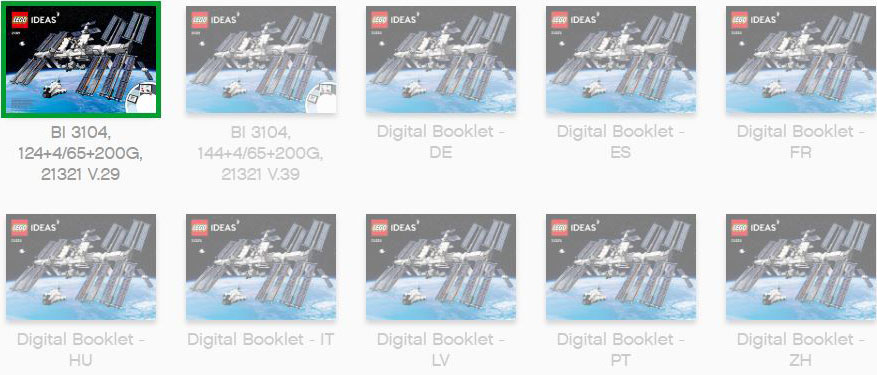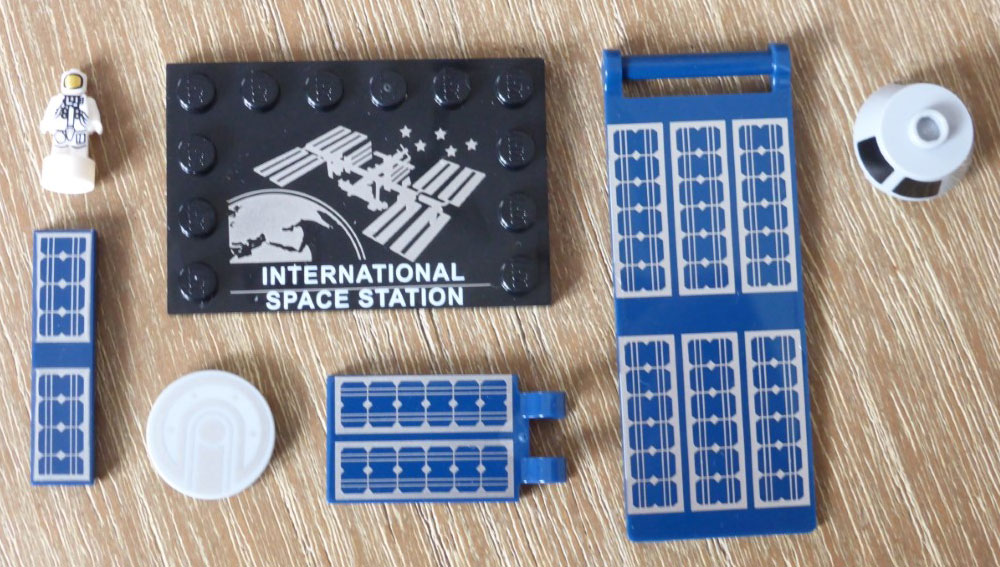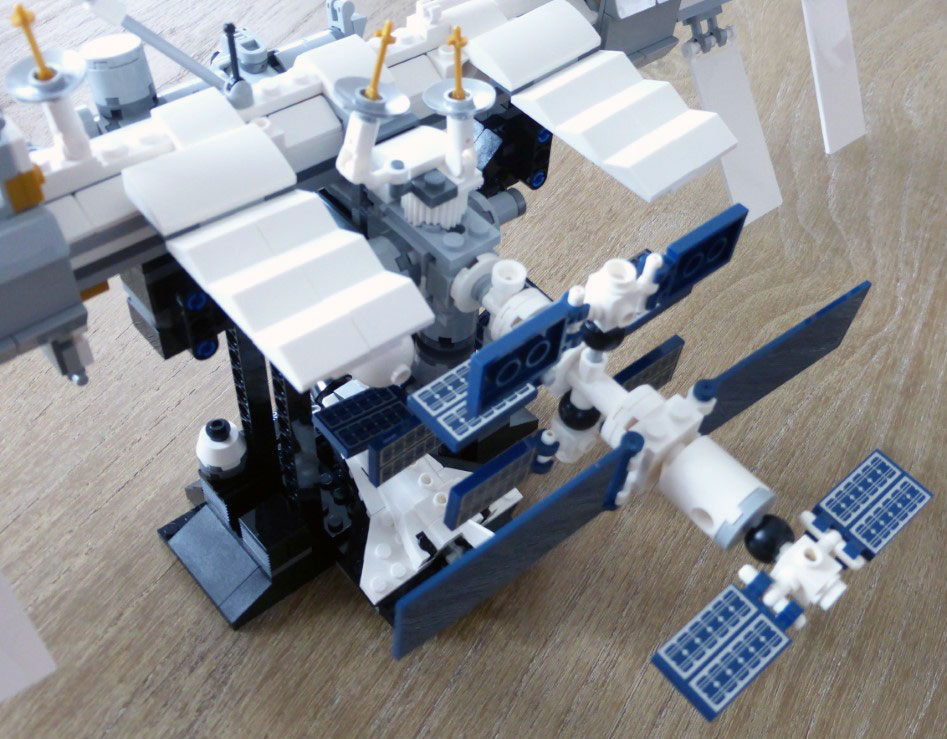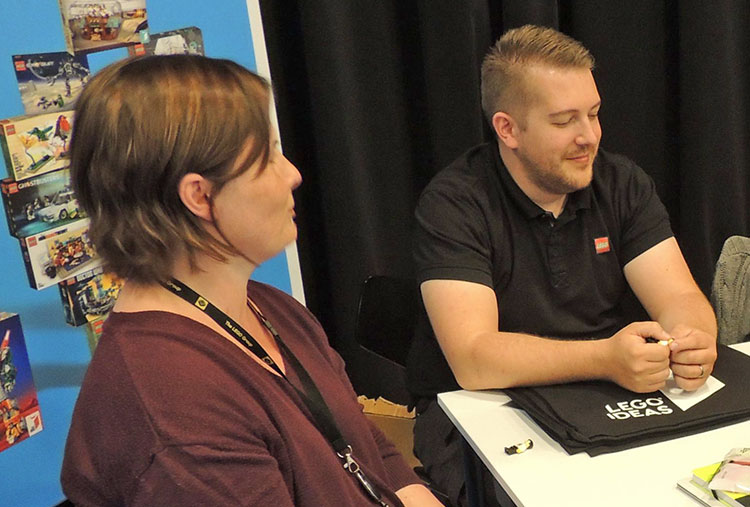Set Review ➟ 21321 International Space Station and Interview with the LEGO Ideas team
At the end of 2018, LEGO Ideas celebrated its tenth anniversary. One of the special ways to celebrate this anniversary was to give a second chance to one of the ideas that got 10,000 votes, but did not make it past the review phase. The LEGO Ideas team selected 4 proposals and during 2019 a vote was held among the fans to decide which set would become an official LEGO Ideas set in 2020. The set was finally announced on January 21st and today we take a closer look at the set after having had the opportunity to build it.

I must say that I have a weakness for NASA theme sets. NASA’s 21309 Apollo Saturn V - also from the LEGO Ideas series - was a dream set. (You can read our review here). The size of the model is impressive, the fact that the set contains exactly 1969 elements (the year the mission was launched) and the whole story told in the construction guide, make it a wonderful experience.
I was also very happy to review the NASA Apollo 11 Lunar Lander. Although it is not a LEGO Ideas set, but rather a Creator Expert set, the set also comes beautifully documented with detailed explanations of the different elements and uses of the original Lunar Lander and how these have been reflected in the LEGO model.
With these two beautiful models in mind, I was excited to see the International Space Station become the model for the celebration of 10 years of LEGO Ideas and had high hopes when I started to review the set.

Like many of the "smaller" sets from LEGO Ideas, the International Space Station (ISS) 21321 comes in a premium cardboard box, which adds considerably to the experience. The instruction manual contains a brief explanation of the agencies involved in this project and how the ISS is an essential laboratory for testing and development in zero gravity. This is followed by the story of amateur designer Christoph Ruge, as well as a few words about the LEGO designers who turned his idea into a set. Next, a celebration of 10 years of LEGO Ideas. The printed booklet comes in English, but the first 12 pages of the booklet are available in 8 additional languages.

The construction of the set is divided into 6 stages. Stage 1 includes 2 astronauts (and a spare). These are exactly the same micro figures that were also included in the 21309 NASA Saturn Apollo V set. Unlike that set, there is no indication of scale of either the micro astronauts or the Space Station, only an indication of the size the model will have. There is also the unmistakable space shuttle, two satellites and... a capsule. There is no indication of what this represents anywhere in the instruction manual, so I can only assume that this must be the return module for the astronauts not boarding the Space Shuttle.

Stage 2 serves to build a support for the model using a mixture of standard bricks, Technic bricks and some Technic beams. It is a simple but robust construction and includes a plate that identifies the model as the International Space Station.

Then it is time to start building the main structure of the ISS, which will serve to link all the other modules to be built during stages 3-5. The final stage adds the large solar panels to the model, although there are already a number of small solar panels during the rest of the construction.

To be perfectly honest, the model is an interesting mosaic of tubes and appendages, but it makes very little sense. If I compare it with the photos of the ISS in the brochure it looks (quite) exact, that is, I can relate several of the characteristics of the LEGO model with the elements of the photo of the real ship. But that's all I can say about the model. Unless you have a specific knowledge of the ISS or decide to investigate it yourself, there is almost no information in the brochure and it is essentially a "blind construction". Both the Saturn V rocket and the lunar lander have construction brochures with considerable educational and documentary value. The ISS has none. It's a great package, but frankly, I have no idea what I just built. There are two robotic arms attached to the model and one of them is articulated. A little Google search tells me that it must be Canadarm2. Most of the solar panels are blue, but there are also big white structures that must be good for something. What a missed opportunity! The whole thing would have really benefited from some explanations about some of the elements you build.

There are more problems with the set. One of the 2 satellites you built in stage 1 connected to the ISS at the end of the construction. So why build it first, like an appetizer? Why is it connected in what seems to be a random position instead of being held in place by the articulated arm? At least there is an image showing that option for the second satellite on the back of the box. It also seems that there is an airlock for the space shuttle to dock, but unfortunately it ends up in a hollow stud, and so does the space shuttle's hull: no connection is possible.

In summary, I must say that this set is a great opportunity lost. Don't get me wrong. I like it very much and it is a good complement to my other NASA models, but I have no idea what I have built, at least not with anything that LEGO has provided me, and in general I am a bit puzzled.

To compensate for these mixed feelings, here is something that will cheer you up: an interview with the LEGO Ideas team that we did some time ago and that explains (among other things) the path that led LEGO Ideas to use this particular model to celebrate its 10th anniversary.
HBM - We have been offered another opportunity to talk to you, after the interview we published in HispaBrick Magazine 026. Let's take a look at what has been launched since then and what is reserved for the future.
MP - My name is Monica Pedersen and I am the marketing manager of LEGO Ideas
SLJ - My name is Samuel Littletop Johnson and I am the Design Manager of LEGO Ideas

>strong>HBM - How has the experience been so far?
SLJ - We have seen the team and the subject grow a lot, especially in the conscience of everyone. Five years ago not many people knew about LEGO Ideas, in general terms, but we have been able to bring to market products that have really arrived and caught the attention and that make people really happy, especially when they are based on a film or a TV programme that people never thought they would have. And there have been some great original ideas along the way as well.
>strong>HBM - Do you think the new voting method that extends deadlines as a project gathers votes is a success?
MP - The decision was made before I came to LEGO Ideas, but I think it is a balanced decision, making sure that the ideas have the right time to get the 10,000 votes...
SLJ - Instead of waiting for everyone to catch up in a few weeks To give the opportunity to gain recognition.
>strong>HBM - Do you think it's fairer?
SLJ – The milestone method is not an uncommon way to go about doing things. It also helps us to find the highest quality projects to keep an eye on. And for the fans it also shows who is really interested in it. By giving it those extensions I think it allows the fans to have time to think about it. They may see a project that has 100 votes and then they can think if they want to vote for that project as well.
HBM - Do you try to somehow detect and avoid voter fraud?
MP – Our technical provider on the platform is scanning for IP addresses and we do check in once in a while on ideas and if we see there is the same IP address 1000 times and we can link it to someone then that ID is excluded. If there is no link it could be a company or a university. We are aware of it and we are doing everything we can.
CS – But we have had very few instances of this actually happening
HBM - Have there been cases of plagiarism? If so, what was done about those cases?
MP – Hesse is so much on top of this. He knows every single submission. He is our old-time all-knowing go-to guy. We can always go to him and he is always on top of this. As a result we don’t ever hear about these things because he clears it out.
SLJ – The rules are very clear. As soon as we see something that might be suspect or see a discussion that something might be suspect we are on top of it.
HBM – Since we last talked you have launched 11 official sets. Each one has its own characteristics and public. Do you think they have all been equally popular?
MP – Well they haven’t. Some products are more popular among the wide population than others. But I don’t think that is the purpose of LEGO Ideas. LEGO Ideas is about trying things out on the platform. It is about creating and giving unique story opportunities, unique product opportunities to experience different things. When you see a product it should be obvious that this could only come from LEGO Ideas. Because that’s the whole idea. It is not about making THE most popular product, That’s not LEGO Ideas. LEGO Ideas is about celebrating the creativity of the community and the great ideas of the fan designers and staying true to that.
HBM – Possibly one of the most successful sets was the NASA Apollo Saturn V. It was sold out only hours after it was launched and there were stock issues for months after. Why did that happen?
MP – You never know how a product is going to perform
SJL – All we know for a fact is that 10.000 people want this. That’s the only thing we know.
MP – First of all there is the design process where we see if we can make a product using pieces that are fairly common, and no new elements, so we can respond quickly if the demand increases. That’s one aspect of it.
SJL – On the NASA Apollo Saturn V we had some challenges with manufacturing. Also, a lot of it is down to local markets deciding how many of each set they want and how many they think they can sell. And then us responding as fast as possible when they run out.
MP – There is a certain response time between when you see a shelf is empty until you can get new ones and this is not a small product. It was the biggest at the time so it takes a little bit of time to replenish that. And that’s one of the reasons. And I don’t think anyone had foreseen the success and how well this one did. There is something special and unique about that set.
SLJ – It has been the best selling LEGO Ideas set. Number two would be “ship in a bottle” which we thought maybe would not be for everyone, and then it was for everyone. It has these big curved bricks that make the shape of the bottle and we found the mold for that had been stored outside and was destroyed so we had to save it and it had to be polished and rebuilt. It had not been used for something like 20 years and we couldn’t believe we still had the mold. When they cleaned it up they said there was only enough for let’s say 250,000 boxes worldwide. And we thought we wouldn’t have enough and it would sell out and we sold out in about 2 days so now the mold must be held together with cellotape or rope or something like that. But they managed to save it until now and it has been crazy how popular that box has been. It totally blew our minds.
HBM – Do you think big sets can be even more successful that the smaller ones because of the level of detail or other factors?
MP – I don’t think the size matters. I think it depends on the models, their execution. We have seen examples of smaller models that work really well. Tron is a good example.
SLJ – If it has a strong message like Women of NASA it sells really well.
MP – You don’t sell the details of the model, you sell a story. And the set comes with a story from the model and also from the fan designer providing ideas. If that is strong enough, the set will sell well.
SLJ – It has been fun to see what fits where. Some models, if we were to put them at say 100$ instead of 50$ maybe they wouldn’t have sold at all. It’s trying to strike a balance of what is the right way to do something. And that is always more important than trying to make money. It is doing things the right way.
HBM - Why are there more licensed than non-licensed sets
MP – It’s not an intentional choice. We have to stay true to what LEGO Ideas is all about. It is the platform of LEGO Ideas where fans submit ideas and projects and other people vote for them. Originally it was about celebrating original ideas and creativity but we also have to acknowledge the fact that there are just a lot of different inputs and inspiration happening and people are often inspired by passion and passion is often driven by stories that are owned by a licenser. Looking at the platform itself, of the concepts that get 10,000 votes about 80% of that is IP and 20% is original. So we have to do what our community wants. We can’t just say we discard the 80%. We have to give the community what they ask for, at least to a large extent. But we do try to see if we can stay true to originals like the ship in a bottle and the old fishing store. Those are really good examples of something that is not IP driven but are very popular.
SLJ – When you think about the IP-related products that we do, most of those are IPs that we would have never done, so the platform gives opportunities for IPs that would otherwise be ignored, like the Flintstones or Doctor Who which would never have been a LEGO product unless we had opened our eyes and looked at LEGO Ideas.
HBM - In the past some of the sets related to Stranger Things that were uploaded were rejected because of “LEGO rules”, but now we have a Stranger Things set. What can you tell the people who were not allowed to upload those ideas and now see this set in the shops?
MP - I think it was addressed in the LAN network. There is a very small team moderating submissions and there are many submissions. And the world changes all the time and sometimes it is about being speedy. We would much rather be conservative when we put things up to the platform than let everything go up. It would be worse to have someone submit an idea and then work for it to reach 10,000 votes and then just be rejected because of something like that. So we often reject things really quickly for the speed of it, to make sure we get the submissions up and we are very conservative. For other products we have a much longer development time where we can sit down and look each other in the eye and say “is this really something we want to do as a company”. We can do extra approval checks with our brand team or whoever we would like to go to to decide that and we don’t have that time on LEGO Ideas for every single submission. And things change. Something we would do today maybe we would not have done in the past, like The Simpsons.
SLJ - The scope of the company is constantly changing with the world. Something that was brand new 20 years ago is now nostalgia and now it has got this whole new life. And for something like Stranger Things it could have been that we had said no because we don’t have the opportunity to work with Netflix, and then a week later Netflix comes and asks “do you want to make a Stranger Things set?”. That decision is way above our say.
HBM - Could you explain what you have done to celebrate 10 years of LEGO Ideas?
SLJ - Last year we had quite a big online event celebrating all the sets. We also had an exhibition in our office that showed the importance of this brand, taking submissions from our fans and bringing them to life, to open our eyes and focus on things that may have been forgotten. MINECRAFT came from here. It was created in this forum and maybe that’s not celebrated enough, so that was the point of our internal celebration. To say “look guys, without us there would be no Ghostbusters. We would never have done it and someone else would have taken the opportunity and we would have lost the opportunity to make people happy.” It is important for us to constantly remind ourselves that the point of LEGO Ideas or LEGO Cuusoo at the time, is to bring new things to LEGO and say “why don’t we do this”.
MP - And in that process of really celebrating the history of LEGO ideas we were looking at some of the any ideas that were either made into a product and also some that reached 10,000 votes but never made it in the review phase for one reason or another and we just thought let’s give these ideas a second chance. Let’s see if we can celebrate all of those ideas and give them a second chance and that’s the anniversary vote. There are currently 131 idas that reached 10,000 votes during the first 10 years and that were declined. And there were a few more that could have reached 10,000 votes but that the owners retired, and that’s fine, they own the ideas. Out of those 131 ideas we did the review first – usually we do that at the end – but of course they still had the same checkpoints. For example the Star Wars submissions are still a no-go and for some things someone else already owned the licensing rights so we reviewed all those sets up front and out of 131 ideas we scaled it down to 9. We boiled that down to 4 and now it is up to the fan community to decide. So for once they decide.
SLJ - It is really nice to see and for them to know that one of them is guaranteed. On some reviews we end up with no models we make into a set, but this time it is guaranteed. That’s pretty cool.
HBM - Do you believe the future of LEGO Ideas is strong? Is the company happy with the results?
MP - I think the company is very happy. Our CEO is promoting the crowdsourcing idea and he actually mentioned LEGO Ideas at the annual meeting for a couple of years in a row during the press conference. That’s pretty clear and pretty awesome. Crowdsourcing in general is something I think we should definitely keep our mind to and LEGO Ideas is a platform that holds many opportunities. Today we use it for a product line that is called LEGO Ideas and we have an X amount of products coming every year, we use it for content sourcing: we have competitions and new activities that have just launched and you can imagine many more things happening and taking place on the platform. I think the future of LEGO Ideas is clear and bright.
HBM - What do you think of the AFOL Design Program on BrickLink?
MP - I like it. I think some of the projects that were rejected on the LEGO Ideas platform have made it to life on the BrickLink platform.
JLS - We are working closely together with that project on BrickLink as well and it has been nice to see how they are planning to handle it.
9291